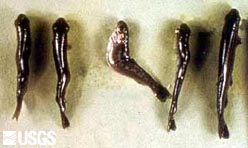- Home
- About S&T
- Taxa/Organisms
- Ecosystems
- Issues
- Methods & Tools
- Reports & Publications
- Location
- Search
Publisher: USGS | Science Center: Western Fisheries Research Center (WFRC, Seattle) | Format: URL
wfrc.usgs.gov — This project addresses the occurrence of metal and organochlorine contaminant residues in commercial feeds purchased by the U.S. Fish and Wildlife Service (FWS) hatcheries. Research into fish feed quality could benefit all hatchery and aquaculture operations and assist in the interpretation of the effects of pollution on wild fish. Results from More...

Publisher: USGS | Science Center: Western Fisheries Research Center (WFRC, Seattle) | Format: URL
wfrc.usgs.gov — Bacterial kidney disease (BKD) is caused by Renibacterium salmoninarum and is considered to be the most difficult salmonid bacterial disease to control, in part because of its dual modes of transmission. This bacterium, unlike most other fish pathogens, is transmitted vertically from parent fish to progeny in association with the eggs, as well as More...

Publisher: USGS | Science Center: Status & Trends | Format: URL
biology.usgs.gov — BEST evaluates environmental contaminants and their effects on species and lands under the stewardship of the Department of Interior to provide scientific information and guide management actions. The BEST Program provides the conceptual framework, leadership, and national coordination to identify spatial and temporal trends in contaminant More...

Publisher: USGS | Science Center: Leetown Science Center (LSC, Kearneysville) | Format: URL
www.lsc.usgs.gov — During the summer and fall of 1996 and 1997, an unusually high prevalence of skin lesions in fishes from the Pocomoke River, Maryland and other tributaries of Chesapeake Bay stimulated significant public concern and scientific interest. This study examined the effect of environmental factors on weakening fish disease resistance of fish to the More...
